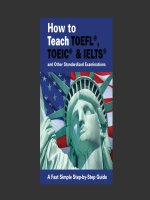How to Teach TOEFL® TOEIC® IELTS® and Other Standardized Examinations ppt
Bạn đang xem bản rút gọn của tài liệu. Xem và tải ngay bản đầy đủ của tài liệu tại đây (2.76 MB, 97 trang )
HowtoTeachTOEFLTOEICIELTSandMore
HowtoTeachTOEFLTOEICIELTSandMore
2
HowtoTeach
TOEFL®TOEIC®IELTS®
andOtherStandardizedExaminations
SecondEdition
Copyright©TEFLeBooksdotcom
Allrightsreserved.
Permissiongrantedtoreproducepartsofthis
publicationaslongasattributionisnoted.
ThisebookwasdevelopedincooperationwithTEFLBootCamp
Tohelpusdoabetterjobofhelpingyou,wewouldappreciate
youropinionaboutthisebook.Pleasetakeourfast,easyand
confidentialsurveyhere:CLICKHERE
HowtoTeachTOEFLTOEICIELTSandMore
3
I.Introduction‐page9
Reasonsfortakingthiscourse
Goalsofthecourse
II.StandardizedTesting‐page10
A.Whatisit?
Whyisitdone?
Whatdothetestspredict?
B.BasicIntroductiontoTestDevelopment
Validity‐Face,Contentandmore
Reliability‐howmeasured
Internalconsistencyoftestsanditems
Howitems(questions)aredeveloped
C.BasicStatisticalConcepts
NormalCurve
"Norming"ate
st‐andstat
isticalcurvesmoothing
StandardDeviationandStandardErrorofTests
**Beforeyoubegin**
Downloadyourcoursenotesat:
www.TEFLeBooks.com/TOEFLnotes.doc
HowtoTeachTOEFLTOEICIELTSandMore
4
III.TOEFL‐Page21
[significantlymoretimeisspentherethanwiththeother
testsasmanybasicswillbecoveredthatwillthentakemuch
lesstimewhenstudyingtheothertests]
A.Overviewofthetest‐whatitisusedfor
Differentformsofthetest:paper,cBT,iBT
B.Howtoselectastudybookforyo
urstudents
Thingstolookfor
Currency
Baselines
Scoring
ProgressTests
C.Howtouseastudybook
Baseline
Strategybuilding
BuildSkills
PracticeSkills
ProgressTesting
HowtoTeachTOEFLTOEICIELTSandMore
5
D.Whattakingthetestislike
E.Skillstested
TypesofQuestions:
Reading
Listening
Writing
Speaking
F.PracticeTestingandrecalibratinggoals
IV.IELTS‐Page30
A.Overviewofthetestandwhatitisusedfor
B.Whattakingthetestislike
C.Skillstesting
TypeofQuestions
Listening
Reading
Writing
Speaking
HowtoTeachTOEFLTOEICIELTSandMore
6
V.TOEIC‐Page31
A.Overviewofthetestandwhatitisusedfor
B.Whattakingthetestislike
C.Skillstestingandhow
Typesofquestionsandstrategies
Listening
Reading
Speaking
Writing
D.Progresstestingandrecalibrationofgoals
VI.TeachingGrammar‐Page37
StructureandAnalysis
FastTrackGrammarReview
Instructionalmethodsfortutorialstudents
HowtoTeachTOEFLTOEICIELTSandMore
7
VII.TeachingStudyandExaminationSkills—Page51
PlanningandRealisticGoalSetting
Settingtheenvironment
Gatheringmaterials
Distributedpractice
SQ3R
Homeworkandassignments(forstudents)
VIII.TeachingReadingSkills‐Page68
Selectingtextsandmaterials
Survey
Skimming
Scanning
Comprehension
DiscriminationTraining
Buildingreadingspeed
Buildingvocabulary
HowtoTeachTOEFLTOEICIELTSandMore
8
IX.TeachingWritingSkills‐Page82
Selectingtextsandmaterials
Organizationofwriting
X.TeachingListeningSkills‐Page84
Selectingtextsandmaterials
Reductions
Linking
Soundchanges
Contentandfunctionwordsandstress
Contractions
Wordendingsandbeginnings
Grammarchallengesinlistening
Outlining
XI.RelatedResources‐Page97
HowtoTeachTOEFLTOEICIELTSandMore
9
WhyTakeThisCourse?
Thiscourseisdesignedtohelpnewly‐trainedandexperiencedEFL
teachersfurtherimprovetheirskillsandcareeroptions.Teaching
specializedskillscoursesinwriting,reading,andlistening;andtest
preparationcoursesforTOEFL,TOEIC,IELTS,etc.isnaturalprogression
asyoumoveupinyourteachingcareer.
GoalsoftheCourse
Thegoalsofthiscoursearetoprovideadditionalskillsthatwillallow
you,withconfidence,toseekmorevariedanddemandingcoursework.
Itisalsointendedthatincreasedskillswillleadtoincreasedjob
satisfaction.
BottomLine
ManyEFLteachershavenoideahowtoteachthemoredemanding
coursessuchasTOEFLorIELTSPreparation,orevenadvancedwriting.
Thiscoursewillshowyouhow.
HowtoTeachTOEFLTOEICIELTSandMore
10
II.StandardizedTesting
A. Whatisstandardizedtesting?
Testsare“standardized”whentheyaredeveloped,administered,and
scoredusingestablishedproceduresandguidelines.Theseprocedures
andguidelinesensurethatallstudentsaretestedunderthesamecon‐
ditions,thattheyareallgivenequalopportunitytodeterminethe
correctanswers,andthatallscoresareestablishedandinterpreted
usingappropriatecriteria.Twotypesofstandardizedtestsare:
1. norm‐referencedtests,usedtocomparestudentperformanceto
thatofotherstudents;and
2. criterion‐referencedtests,usedtomeasurestudentperformance
againstadefinedsetoflearningrequirementsorexpectations.
Indevelopingstandardizedtests,testdevelopersfollowestablished
procedurestocreatequestionsthatreflectthecurriculaorthelearning
requirements.Theyalsoanalyzethetesttoensurethatitmeasures
studentperformanceaccuratelyandreliably.Whenstandardizedtests
aregiventostudents,thereareprescribeddirectionsforhowthetestis
tobeadministeredandeverytestgivenineverysettingmustbegiven
underthesameconditionstoensurethatnoonehasanadvantage.
Themoreyouknowaboutthetypeoftest
beinggiven,howitisdeveloped,administered,
scored,andinterpreted,themoreinsightyou
willhaveinunderstandingthetestingprocess,
itsoutcomes,and,ultimately,inmaking
decisionsregardingastudent’seducation.
(PearsonEducationalMeasurement)
HowtoTeachTOEFLTOEICIELTSandMore
11
Inscoringstandardizedtests,manualandcomputer‐assistedanalyses
doublecheckthescoringprocesstoensurethateverystudent’sscoreis
accurate.Interpretingstandardizedtestscoresisacriticalprocess
becausethedecisionscanhavesignificantimpactonstudents’lives.
Manyguidelinesgovernhowtestresultscanbeappliedandwhat
evidence(usuallystatisticalanalysis)isneededtosupportvarioususes.
(adaptedfromPearsonEducationalMeasurement)
Whyarestandardizedtestsused?Whatdotheteststellus?
StandardizedtestssuchatTOEFLandIELTSandothersareusually
administeredtodetermine,orpredict,astudent’slikelihoodofsuccess
inanEnglish‐speakingacademicsetting.TOEICisusedtomeasureand
predictthesubject’sskillsusingEnglishinanEnglish‐speakingwork
environment.
Someinterestingcorrelations
Controversysurroundsstandardizedtestsastheytendtobeone‐
dimensionalandmeasureonlycertainaspectsofaperson’sability/
skill.Theymaynotmeasureotherimportantaspectssuchassocial
skillsordeterminationtosucceed.IQtests,forexample,canwell
predictthegrossincomeofthesubject’sparents,oreventhenumber
ofbooksinherparents’house.Thusthetestsometimespossibly
bettermeasureswealthorresourcesavailabletothestudentthan
nativeability.
HowtoTeachTOEFLTOEICIELTSandMore
12
B.IntroductiontoTestDevelopment
Validity
Howdoweknowwhetheratestmeasurestheabilityinwhichweare
interested?Evenifatestisperfectlyreliableandvirtuallyerror‐free,
howdoweknowifitismeasuringtheabilitieswewantittomeasure
andnotsomethingelse?Thisistheideaandcentralconcernofvalidity,
andultimatelyinvolvesthekindsofjudgmentsthatcanbedrawnfrom
testscores.
Let'sconsideramathtestconsistingonlyofwordproblems.Thetest
scorecouldappropriatelybeusedtoindicatethestudent'sabilityto
solvemathproblemsthatrequirereading;thatwouldbeavaliduseof
thetestscore.However,usingthetestscoreasarepresentationofthe
student'smathabilityingeneralmightnotbevalid,especiallyifthe
studentwasnotfluentinthelanguageinwhichthewordproblems
werewritten.
Peoplewhodeveloptestsanalyzetheminseveralwaystodetermine
theappropriate(i.e.,valid)useoftestscores.Let'sreviewsomeofthe
issuesconsideredindeterminingthevaliduseoftestscores:
HowtoTeachTOEFLTOEICIELTSandMore
13
Dothequestionsonthetestrepresenttheentiresubjectmatter
aboutwhichconclusionsaretobedrawn?Forinstance,ifatestis
designedtomeasuregeneralarithmeticability,thereshouldbe
questionsaboutaddition,subtraction,multiplication,anddivision.
Iftherearenoquestionsaboutdivision,thetestdoesnotmeasure
theentirecontentofarithmetic,sothetestscorecannotbesaidto
reflectgeneralarithmeticability.
Isthestudentrequiredtodemonstratetheskillthatthetestis
intendedtomeasure?Testsshouldbedirectlytargetedtotheskills
measuredandthatskillshouldaffecttestperformance.For
example,atestdesignedtomeasurewritingproficiencyshouldask
testtakerstowritesomething,andbetterwritersshouldbeshown
toreceivehigherscores.
Arethetestscoresconsistentwithotherindicatorsofthesame
knowledgeandskills?Supposeastudenttakesatestdesignedto
measurewritingability.Ifthestudentdoeswellonwritingassign‐
mentsinclass,thenheorsheshouldalsodowellonthewriting
test,solongasthetypeofwritingonthetestisconsistentwiththat
doneinclass.Ontheotherhand,studentswhodonotperformwell
onwritingassignmentsinclassshouldnotdoaswellonthetest.
Thevalidityofusingthattestscoreasanindicationoftheperson's
abilityisquestionableifthereisinconsistencybetweenthetest
scoreandclassroomperformance.
HowtoTeachTOEFLTOEICIELTSandMore
14
Reliability
Theconsistencyofscoresacrossdifferentadministrationsorscorersis
knownasreliability.Itiscrucialthattestscoresbeadequatelyreliable
inrepresentingaperson'sknowledgeandskills.Someleveloferroris
alwaysafactorintesting(moreonthislater)andtestscores.Ifa
persontakesthesametestondifferentdays,wecanexpecttheresults
tobeslightlydifferent,butthemoreerrorthereisinthetest's
make‐up,themoredifferentthetwotestscoresarelikelytobe.Ifthe
twotestscoresareverydifferent,itisreasonabletoconcludethatthe
differenceisduetotesterrorandthatthescoresdonotreallyreflect
whatthetesttakerknowsandisabletodo.
Inconsistenciesinscoringtestsmightalsoundercutreliability.Some
testsarecomposedofmultiple‐choicequestions,whileothersrequire
thatthetesttakerconstructaresponse,suchasanessay.Scoringa
multiple‐choicequestionisstraightforward,becausethereisoneright
answer;theanswerprovidediseithercorrectorincorrect.Therefore,
regardlessofwhoscoresthetest,thescoreonthatquestionwillbethe
same.Essay‐typequestions,however,requirehumanjudgmentandare
thereforemoredifficulttoscore.Iftwopeoplereadthesameessay,it's
likelythateachpersonwillgivetheessayaslightlydifferentscore.
However,ifthetwoscoresgivenbythetwoscorers,or"raters,"are
verydifferent,thenthescoreonthatessayisnotveryconsistentand
thusnotveryreliable.
HowtoTeachTOEFLTOEICIELTSandMore
15
Themeasureofconsistencybetweenscorersiscalledinter‐rater
reliability.Thecloserthescoresassignedtoanessaybydifferent
raters,thehighertheinter‐raterreliabilityofthattest.Whileitmight
seemimpossibletogetdifferentraterstoassignexactlythesame
score,itispossibletotrainraterssothattheyallscoreinaverysimilar
way.Ifthisgoalisaccomplished,therecanbemoreconfidencethatthe
scoreassignedtotheessayreflectstheabilityofthestudent.
BasicStatisticalConcepts
The“Normal”Curve
StandardizedtestssuchastheTOEFL,IELTS,andTOEICforcescoresinto
a“normal”orbell‐shapedcurve—suchastheonetotheleft.
Intelligencetestsalsodothis.
Anormaldistributionofdatameansthatmostoftheexamplesinaset
ofdataareclosetothe"average,"whilerelativelyfewerexamplesare
atoneextremeortheother.
Let'ssayyouarewritingastoryaboutnutrition.Youneedtolookat
people'stypicaldailycalorieconsumption.Likemostdata,thenumbers
forpeople'stypicalconsumptionprobablywillturnouttobenormally
distributed.Thatis,formostpeople,theirconsumptionwillbecloseto
themean,whilefewerpeopleeatalotmoreoralotlessthanthe
mean.
Exampleofa“normal”curveornormal
distributionofscoresonatest
HowtoTeachTOEFLTOEICIELTSandMore
16
TheStandardDeviation
Thestandarddeviationisastatisticthattellsyouhowtightlyallthe
variousexamplesareclusteredaroundthemeaninasetofdata.When
theexamplesareprettytightlybunchedtogetherandthebell‐shaped
curveissteep,thestandarddeviationissmall.Whentheexamplesare
spreadapartandthebellcurveisrelativelyflat,thattellsyouthatyou
havearelativelylargestandarddeviation.
Computingthevalueofastandarddeviationiscomplicated.Butlet’s
seegraphicallywhatastandarddeviationrepresents(seecharttothe
left).
Onestandarddeviationawayfromthemeanineitherdirectiononthe
horizontalaxis(thefirstareatotherightandtotheleftofthemeanon
theabovegraph)accountsforsomewherearound68percentofthe
peopleinthisgroup.Twostandarddeviationsawayfromthemean
(thefirstfourareas)accountforroughly95percentofthepeople.And
threestandarddeviations(thesixareas)accountforabout99percent
ofthepeople.
Ifthiscurvewereflatterandmorespreadout,thestandarddeviation
wouldhavetobelargerinordertoaccountforthose68percentorso
ofthepeople.Sothat'swhythestandarddeviationcantellyouhow
spreadouttheexamplesinasetarefrom
themean.
HowtoTeachTOEFLTOEICIELTSandMore
17
Whenyouthinkaboutit,that'sjustcommonsense.Notthatmany
peoplearegettingbyonasingleservingofkelpandrice.Oroneight
mealsofsteakandmilkshakes.Mostpeopleliesomewherein
between,closertothemiddle.
Ifyoulookedatnormallydistributeddataonagraph,itwouldlook
somethinglikethechartontheleftofthispage.
Thex‐axis(thehorizontalone)isthevalueinquestion calories
consumed,dollarsearnedorcrimescommitted,forexample.Andthe
y‐axis(theverticalone)isthenumberofdatapointsforeachvalueon
thex‐axis inotherwords,thenumberofpeoplewhoeatxcalories,
thenumberofhouseholdsthatearnxdollars,orthenumberofcities
withxcrimescommitted.
Now,notallsetsofdatawillhavegraphsthatlookthisperfect.Some
willhaverelativelyflatcurves,otherswillbeprettysteep.Sometimes
themeanwillleanalittlebittoonesideortheother.Butall“normally
distributed”datawillhavesomethinglikethissame"bellcurve"shape.
HowtoTeachTOEFLTOEICIELTSandMore
18
Whyisthisuseful?Here'sanexample:Ifyouarecomparingtestscores
fordifferentschools,thestandarddeviationwilltellyouhowdiverse
thetestscoresareforeachschool.
Let'ssaySpringfieldElementaryhasahighermeantestscorethan
ShelbyvilleElementary.Yourfirstreactionmightbetosaythatthekids
atSpringfieldaresmarter.
Butabiggerstandarddeviationforoneschooltellsyouthatthereare
relativelymorekidsatthatschoolscoringtowardoneextremeorthe
other.Byaskingafewfollow‐upquestionsyoumightfindthat,say,
Springfield'smeanwasskewedupbecausetheschooldistrictsendsall
ofthegiftededucationkidstoSpringfield.OrthatShelbyville'sscores
weredraggeddownbecausestudentswhorecentlyhavebeen
"mainstreamed"fromspecialeducationclasseshaveallbeensentto
Shelbyville.
Inthisway,lookingatthestandarddeviationcanhelppointyouinthe
rightdirectionwhenaskingwhyinformationisthewayitis.
Thestandarddeviationcanalsohelpyouevaluatetheworthofall
thoseso‐called"studies"thatseemtobereleasedtothepress
everyday.Alargestandarddeviationinastudythatclaimstoshowa
relationshipbetweeneatingTwinkiesandkillingpoliticians,for
example,mighttipyouoffthatthestudy'sclaimsaren'tallthat
trustworthy.
CredittoRobertNilesforhis
excellentdescriptionofthese
statisticalconcepts.
HowtoTeachTOEFLTOEICIELTSandMore
19
"Norming"atest‐andstatisticalcurvesmoothing
Teststhatdon’tnaturallyfitintoa“normal”curvecanbeforcedor
adaptedtoanormalcurveviatheuseofstatisticalmethods.
Errorintestscores
Asweexplainedatthebeginningofthissection,someerrorisalwaysa
factorintestscoreinterpretation.Infact,testssimplycannotprovide
informationthatis100%accurate.Thismightsoundsurprising,butthis
istrueformanyreasons;forexample:
Theextenttowhichastudenthaslearnedthebreadthanddepthof
asubjectwillinfluencehowsheorheperformsonatest.Ona
readingtest,forexample,astudentmightdowellwithquestions
aboutwordmeaningandfindingthemainideaofapassagebut
havehadlesspracticedistinguishingfactfromopinion.The
experience(orlackthereof)thatatest‐takerbringstothetest
representsasourceoferrorintermsofusingthetestscoreto
generalizeaboutthestudent'sreadingability.
Sometimesastudenttakingatestisjustplainunlucky.Ifastudent
istired,hungry,nervous,orevenjusttoowarm,heorshemightdo
worseonthetestthanifthecircumstancesweredifferent.
Atestmighthavequestionsthatseemtrickyorconfusing.Ifa
studentisnotclearaboutthemeaningofaquestion,heorshewill
havetroublefindingthecorrectanswer.
HowtoTeachTOEFLTOEICIELTSandMore
20
Standarderrorofmeasurement
Thescoreapersongetsonthetestismeanttoindicatehowwell
thatpersonknowstheinformationbeingtested.Onewayof
lookingatatestscoreistothinkofitasconsistingoftwoparts.
Onepartrepresentstherealbutunknowabletrueabilityofa
person.Thispartisunknowablebecauseitisneverpossibletoget
insidesomeone'sheadandhaveaperfectmeasureoftheirability
intheareaofinterest.Theotherpartofatestscorerepresentsthe
error,allthethingsthatmakethetestaless‐than‐perfectsnapshot
ofsomeone'sknowledgeatonemomentintime.Unlikethewaywe
canmanufactureayardstickthatisexactlythreefeetlongto
measurelength,eventhebesttestscanprovidescoresthatareonly
approximationsofthetrueability.
Unfortunately,itisimpossibletobreakthesetwopiecesofatest
score(thetrueabilityanderror)apart.Butitisimportantto
understandthatanytestscorecontainsacertainamountoferror,
andaswe'veillustratedtheerrormightbeduetothingsthatare
goingonwiththetesttakerorthingsthatinvolvehowthetestis
createdorscored.Errorsintestscorescannotbecompletely
eliminated,butfortunatelytherearetechniquesthatcanbeused
toprovidesomeideaabouthowmuchthescoreisaffectedby
error.
Testingspecialistscancalculatethe
standarderrorofmeasurement,whichcan
bethoughtofastherangeofscores
obtainedbythesamepersontakingthe
sametestmanytimes.
Thestandarderrorofmeasurementisa
"bestguess"abouthowclosethetestisto
measuringaperson'sknowledgeorskill
with10
0%
accura
cy.
Thestandarderrorofmeasurementisa
statisticalestimateofhowfaroffthetrue
scorethetestscoreislikelytobe.
HowtoTeachTOEFLTOEICIELTSandMore
21
III.TOEFL
A. Overviewofthetest
TOEFL®standsfortheTestofEnglishasaForeignLanguage.Thistestis
designedtomeasuretheEnglishlanguageabilityofpeoplewhodonot
speakEnglishastheirfirstlanguageandwhoplantostudyatcolleges
anduniversities.
AbouttheTOEFLTest
TosucceedinanacademicenvironmentinwhichEnglishisthe
languageofinstruction,internationalstudentsneedtonotonly
understandEnglish,butalsotocommunicateeffectively.TheTestof
EnglishasaForeignLanguage(TOEFL)isatestthatassessesallfour
basiclanguageskills:listening,reading,writing,andspeaking.The
TOEFLiBT(Internet‐basedtest)helpsindividualsdemonstratethe
Englishskillsneededforacademicsuccess,aswellashelpinstitutions
makebetterdecisionsaboutprospectivestudents'readinessfor
academiccourseworkincollegesanduniversities.
Morethan6,000institutionsand
agenciesin110countriesrelyon
TOEFLscorestoselectstudentswith
theEnglishskillsneededtosucceedin
anacademicsetting.
HowtoTeachTOEFLTOEICIELTSandMore
22
WhoShouldTaketheTOEFLTest?
ETS,thecompanythatdevelopedtheTOEFLtestrecommendsthat
non‐nativeEnglishspeakersatthe11th‐gradeleveloraboveshould
taketheTOEFLtesttoprovideevidenceoftheirEnglishproficiency
beforebeginningacademicworkinEnglish.Thetestcontentis
consideredtoodifficultforstudentsbelow11thgrade.
SomeinstitutionsdonotrequireTOEFLtestscoresofthefollowing:
Non‐nativespeakerswhoholddegreesordiplomasfrom
postsecondaryinstitutionsinEnglish‐speakingcountries(e.g.,the
UnitedStates,Canada,England,Ireland,Australia,NewZealand)
nonnativespeakerswhohavesuccessfullycompletedatleasta
two‐yearcourseofstudyinwhichEnglishwasthelanguageof
instruction
transferstudentsfrominstitutionsintheUnitedStatesorCanada
whoseacademiccourseworkwasfavorablyevaluatedinrelationto
itsdemandsandduration.
nonnativespeakerswhohavetakentheTOEFLtestwithinthepast
twoyears
nonnativespeakerswhohavesuccessfullypursuedacademicwork
atschoolswher
eEnglishwasthelanguageofinstructioninan
English‐speakingcountryforaspecifiedperiod,generallytwoyears.
WhyTaketheTOEFLTest?
MostpeopletaketheTOEFLtestasa
prerequisiteforadmissioninto
collegesanduniversitieswhere
Englishisusedorrequired.In
addition,manygovernment,
licensing,andcertificationagencies,
andexchangeandscholarship
programsuseTOEFLscoresto
evaluatetheEnglishproficiencyof
peopleforwhomEnglishisnottheir
nativela
ngu
age.Thetestpredicts
successinanacademicsettinginan
Englishspeakingcountry.
HowtoTeachTOEFLTOEICIELTSandMore
23
FormsoftheTest
ThetestcomesinthepBTandiBTforms‐meaningthepaper‐based
test(beingphasedout)andtheInternet‐basedtest(tobecomethe
standard).ThecBTorcomputer‐basedtesthasbeenphasedout.
Wewillfocusonthetestitselfhereandnottheforminwhichitis
administered.
B.Howtoselectastudybookforyourstudents
Lookforastudymanualthathasabaselineexaminationandatleast
three,preferablyasmanyassixormore,practicetests,aswellasgood,
clearexplanationsofthetestandtestitems.Thestudymanualshould
becurrentandpublishedwithinthelasttwoyears.
Abaselineexaminationwillhelpyouandyourstudentstogetagood
senseoftheircurrentstrengthsandweaknessesontheareasofthe
test.Thiswillhelpyouknowwhatthestudentsneedtoworkonmost
toimprovetheirscores.
Progresstestswillhelpyouandyourstudentsmeasuretheir
improvementasyouguidetheirstudies.
Agoodmanualshouldhaveaclear
explanationofthescoringsystemof
theexaminationtohelpyouknow
justhowfaryourstudentsarefrom
theirgoal.
Studentsshouldknow,oraskyouto
helpthemdiscover,thescorethey
needforadmissiontotheuniversity
orinstitutiontheywishtoat
tend.
HowtoTeachTOEFLTOEICIELTSandMore
24
C.Howtouseastudybook
Onceyouhavechosenastudymanual,readthedirectionscarefully.
Typically,thefirst10‐40pagesofamanualwillgiveverydetailed
instructionsonhowtobeststudyforthetest,test‐takingtips,and
basicinformationaboutthetest.Asmartinstructor[you]willtakethe
testatleastoncesotheyknowexactlywhatisentailed.
Buildingagoodstudyplanisanessentialfirststepinhelpingyour
students.But,first,youmustknowtheskilllevelofyourstudentsand
wheretheirskillsarestrongandweak.Thiswillrequiregivingyour
studentsabaselinetesttodeterminetheircurrentskilllevels.
Onceanestimatedbaselinescorehasbeenestablished,carefully
reviewyourstudents’skilllevelsanddevelopastudyplanthatwill
helpraiselowerscoresandstrengthenthehigherscores.
Irregularityofskilllevels(strongverbalskillsandveryweakwriting
scores,forexample)arenotuncommonandworkingonraisingthe
lowerlevelskillswill,mostlikely,yieldthequickestresults(ETS
researchsuggeststhisistrue).
Studentswilloftenwanttostudyintensivelyforshortperiodsoftime,
buttheywillgenerallybemoresuccessfulwithdistributedpractice
overlongerperiodsoftime.
Baseline,practiceand
progresstestsshouldbe
takenunderconditions
ascloseaspossibleas
thoseatatestingcenter.
HowtoTeachTOEFLTOEICIELTSandMore
25
Itisnotuncommonforstudentstowanttotakeamajorexamination
infourweeksorevenlessandexpectthattheycansignificantlyraise
theirscoresinthatperiodoftime.Suchanapproachisusually
self‐defeatingandshouldbediscouraged.
Manymajortestsrequireaminimumofthreemonthstopassbetween
examinationsastheyhavegoodresearchthatindicatesthatstudent
scorestypicallydonotchangesignificantlyiflesstimeisinvolved,
Oncethestudyplanisimplementedandthestudentsareworking
regularly,administerperiodicpracticeteststomeasureimprovements.
Thepurposeofthisistogivethestudentfeedbackontheir
improvementandtogivethempracticeintheactualtakingofthetest.
Thereisalsoapracticeeffectwithsuchtestsandstudentscanimprove
theirscoresslightlywithonlypractice.
Familiaritywiththetestwillhelpstudentsbetterjudgehowmuchtime
isallowedforeachquestion,forreading,fordraftingandcorrecting
theirwriting,fortakingnotesforconversationalcomponents,for
doublecheckingthateachquestionhasbeenanswered,etc.









